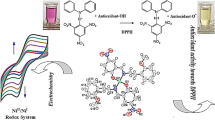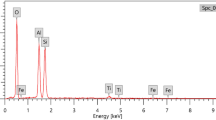Abstract
A method for the synthesis of naphthoquinone with an additional redox-active paramagnetic group, namely, 2-bromo-3-(4-(4,4,5,5-tetramethyl-3-oxide-1-oxylimidazolidin-2-yl)phenoxy)naphthalene-1,4-dione, was developed by reacting 1,2-dibromonaphtho-quinone with 2-(4-hydroxyphenyl)-4,4,5,5-tetramethyl-2-imidazoline-3-oxide-1-oxyl in DMF in the presence of K2CO3. The molecular and crystal structure of the paramagnetic compound was solved using an X-ray diffraction analysis. According to the data of cyclic voltammetry the oxidation of the nitroxide group in spin-labeled naphthoquinone occurs reversibly at E1/2 = 0.513 V (vs. Ag/AgCl), and its reduction proceeds at a peak potential of −1.33 V and exhibits a corresponding oxidation peak. The electrochemical activity of the naphthoquinone fragment manifests itself in the cathode region and is expressed as a group of two successive peaks at potentials of −0.72 and −1.49 V, the first of which has the characteristics of a quasi-reversible process, the second one also exhibits a corresponding oxidation wave.
Similar content being viewed by others
References
E. V. Tretyakov, V. I. Ovcharenko, A. O. Terent’ev, I. B. Krylov, T. V. Magdesieva, D. G. Mazhukin, N. P. Gritsan, Russ. Chem. Rev., 2022, 91, RCR5025; DOI: https://doi.org/10.1070/RCR5025.
V. I. Ovcharenko, A. O. Terent’ev, E. V. Tretyakov, I. B. Krylov, Russ. Chem. Rev., 2022, 91, RCR5043; DOI: https://doi.org/10.1070/RCR5043.
P. A. Fedyushin, I. A. Zayakin, S. E. Tolstikov, A. V. Lalov, A. Ya. Akyeva, M. A. Syroeshkin, G. V. Romanenko, E. V. Tretyakov, M. P. Egorov, V. I. Ovcharenko, Russ. Chem. Bull., 2022, 71, 722; DOI: s11172-022-3472-8.
G. V. Romanenko, O. V. Kuznetsova, E. V. Tretyakov, V. I. Ovcharenko, Russ. Chem. Bull., 2021, 70, 864; DOI: https://doi.org/10.1007/s11172-021-3160-0.
E. V. Tretyakov, P. A. Fedyushin, Russ. Chem. Bull., 2021, 70, 2298; DOI: https://doi.org/10.1007/s11172-021-3346-5.
P. A. Fedyushin, A. Ya. Akyeva, M. A. Syroeshkin, T. V. Rybalova, D. V. Stass, V. A. Korolev, E. V. Tretyakov, M. P. Egorov, Russ. Chem. Bull., 2022, 71, 1474; DOI: https://doi.org/10.1007/s11172-022-3553-8.
S. Nakatsuji, M. Nobusawa, H. Suzuki, H. Akutsu, J. Yamada, J. Org. Chem., 2009, 74, 9345; DOI: https://doi.org/10.1021/jo902007m.
M. Nobusawa, H. Akutsu, J. Yamada, S. Nakatsuji, Chem. Lett., 2008, 37, 788; DOI: https://doi.org/10.1246/cl.2008.788.
Y. Shibata, H. Akutsu, J. Yamada, M. Satoh, U. S. Hiremath, C. V. Yelamaggad, S. Nakatsuji, Chem, Lett., 2010, 39, 671; DOI: https://doi.org/10.1246/cl.2010.671.
R. Kumai, M. M. Matsushita, A. Izuoka, T. Sugawara, J. Am. Chem. Soc., 1994, 116, 4523; DOI: https://doi.org/10.1021/ja00089a070.
E. V. Tretyakov, P. A. Fedyushin, E. V. Panteleeva, D. V. Stass, I. Yu. Bagryanskaya, I. V. Beregovaya, A. S. Bogomyakov, J. Org. Chem., 2017, 82, 4179; DOI: https://doi.org/10.1021/acs.joc.7b00144.
P. Fedyushin, E. Panteleeva, I. Bagryanskaya, K. Maryunina, K. Inoue, D. Stass, E. Tretyakov, J. Fluor. Chem., 2019, 217, 1; DOI: https://doi.org/10.1016/j.jfluchem.2018.10.016.
P. Fedyushin, L. Gurskaya, E. Panteleeva, B. Koshcheev, A. Maksimov, T. V. Rybalova, E. Zaytseva, E. Tretyakov, Fluorine Notes, 2019, 123, 7; DOI: https://doi.org/10.17677/fn20714807.2019.02.04.
S. I. Zhivetyeva, I. A. Zayakin, I. Yu. Bagryanskaya, E. V. Zaytseva, E. G. Bagryanskaya, E. V. Tretyakov, Tetrahedron, 2018, 74, 3924; DOI: https://doi.org/10.1016/j.tet.2018.05.075.
M. M. Petrova, S. I. Zhivetyeva, E. V. Tretyakov, SDRP J. Comput. Chem. & Mol. Model., 2018, 2, 1; DOI: https://doi.org/10.25177/JCCMM.2.2.5.
E. V. Tretyakov, V. I. Ovcharenko, Russ. Chem. Rev., 2009, 78, 971; DOI: https://doi.org/10.1070/RC2009v078n11ABEH004093.
F. H. Allen, O. Kenard, D. G. Watson, L. Bramer, A. G. Orpen, R. Taylor, J. Chem. Soc., Perkin Trans. II, 1987, 12, S1; DOI: https://doi.org/10.1039/p298700000s1.
F. Scholz, Electroanalytical Methods. Guide to Experiments and Applications, 2nd ed., Springer-Verlag, Berlin Heidelberg, 2010; DOI https://doi.org/10.1007/978-3-642-02915-8.
A. J. Bard, L. R. Faulkner, Electrochemical Methods: Fundamentals and Applications, 2nd ed. Wiley, New York, 2001; DOI: https://doi.org/10.1023/A:1021637209564.
E. F. Ullman, J. H. Osiecki, D. G. B. Boocok, R. Darcy, J. Am. Chem. Soc., 1972, 94, 7049; DOI: https://doi.org/10.1021/ja00775a031.
I. Yu. Barskaya, S. L. Veber, E. A. Suturina, P. S. Sherin, K. Yu. Maryunina, N. A. Artiukhova, E. V. Tretyakov, R. Z. Sagdeev, V. I. Ovcharenko, N. P. Gritsan, M. V. Fedin, Dalton Trans., 2017, 46, 13108; DOI: https://doi.org/10.1039/c7dt02719b.
T. Petrenko, F. Neese, J. Chem. Phys., 2007, 127, 164319; DOI: https://doi.org/10.1063/1.2770706.
J. Yongjian, X. Yanjie, N. Rong, C. Fengjuan, Z. Zhenping, W. Jianguo, J. Huanwang, J. Mater. Chem. A, 2017, 5, 5495; DOI: https://doi.org/10.1039/C6TA10231J.
H. Wang, J. Wang, Q. Yang, X. Zhang, P. Gao, S. Xu, X. Sun, Y. Wang, Neurochem. Res., 2015, 40, 1526; DOI: https://doi.org/10.1007/s11064-015-1602-5.
G. M. Sheldrick, SADABS. Version 2.01. Bruker AXS Inc. Madison, Wisconsin (USA), 2004.
G. M. Sheldrick, Acta Crystallogr. C, 2015, 71, 3; DOI: https://doi.org/10.1107/S2053229614024218.
A. L. Spek, PLATON—A Multipurpose Crystallographic Tool (Version 10M), Utrecht University, Utrecht (The Netherlands), 2003.
A. L. Spek, J. Appl. Crystallogr., 2003, 36, 7; DOI: https://doi.org/10.1107/S0021889802022112.
C. F. Macrae, P. R. Edgington, P. McCabe, E. Pidcock, G. P. Shields, R. Taylor, M. Towler, J. van de Stree, J. Appl. Crystallogr., 2006, 39, 453; DOI: https://doi.org/10.1107/S002188980600731X.
Author information
Authors and Affiliations
Corresponding author
Additional information
No human or animal subjects were used in this research.
The authors declare no competing interests.
Evgeny Tretyakov, born in 1968, Doctor of Sciences, Chemistry, Deputy Director for Research, Head of the Laboratory of Paramagnetic Materials and Molecular Spin Systems of the N. D. Zelinsky Institute of Organic Chemistry of the Russian Academy of Sciences, candidate for Corresponding Member of the Russian Academy of Sciences in the elections of 2022. He is an expert in the field of paramagnetic materials, high-spin organic and organometallic systems, molecular design of magnets, author of 215 scientific papers and 3 patents. He developed a directed synthesis of a wide range of paramagnetic compounds and their structural diamagnetic analogues, investigated copper-nitroxide complexes exhibiting the effects of thermally and photo-induced spin transitions. He has developed approaches to various high-spin organic systems, thermally stable bi- and triradicals with the topology of trimethylenemethane, consisting of spin carriers of different nature. A series of fullerene-stable radical dyads containing linkers with different lengths and geometries have been created. This opens up new opportunities for the development of ESR technologies, implementation of quantum logic operations, qubits and qudits. A new direction has been created at the intersection of the synthetic chemistry of graphene nanomaterials and stable organic radicals, which involves the step-by-step assembly of spin-labeled nanographene structures for the development of technologies in the field of spintronics. Prof. Tretyakov teaches at the Higher College of Chemistry of the Russian Academy of Sciences, the D. I. Mendeleev Russian University of Chemical Technology (lecture course “Magnetochemistry and molecular design of magnets”). Three PhD theses were defended under his supervision. Prof. Tretyakov represents the interests of the Russian Federation in the framework of the Stockholm Convention on Persistent Organic Pollutants, and he is a permanent member of the Expert Group on Persistent Organic Pollutants of the Arctic Council.
Published in Russian in Izvestiya Akademii Nauk. Seriya Khimicheskaya, Vol. 72, No. 1, pp. 213–222, January, 2023.
Rights and permissions
About this article
Cite this article
Zayakin, I.A., Akyeva, A.Y., Syroeshkin, M.A. et al. Synthesis, structure, and electrochemistry of nitronyl nitroxide-substituted 1,4-naphthoquinone. Russ Chem Bull 72, 213–222 (2023). https://doi.org/10.1007/s11172-023-3726-0
Received:
Revised:
Accepted:
Published:
Issue Date:
DOI: https://doi.org/10.1007/s11172-023-3726-0




